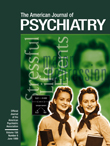Drs. Freeman and Stoll Reply
To the Editor: We would like to thank R. Walter Lovell, M.D., for his important comments. As he indicated, the risk of serious rashes is much higher in the pediatric population than in adults. The topic of bipolar disorder in children and adolescents deserves substantial consideration, and we feel that we could not have adequately covered this information in our article. But because Dr. Lovell drew our attention to it, we would like to discuss a few other relevant matters regarding bipolar disorder in children and adolescents.
First, diagnosis itself is generally quite challenging in this population. Presentations may be atypical, are commonly confused with other disorders, and are often seen in the context of significant comorbidity (1–3). As a result, bipolar disorder in children and adolescents is most likely underdiagnosed or inappropriately treated or both.
Mood stabilizers have not been well studied in the treatment of children and adolescents. Moreover, adequate research has not been conducted regarding combinations of mood stabilizers in children with bipolar disorder. Much of what we know about anticonvulsants in this population is based on studies of epilepsy. In addition to the increased risk of rashes with lamotrigine, other mood stabilizers may pose distinct risks in the pediatric population. For instance, valproic acid may cause a higher risk of liver failure (4) and thrombocytopenia (5) in children. Also, gabapentin has been reported to cause behavioral side effects (6, 7) Carbamazepine has been reported to be well tolerated in children (8), but cases have been reported that suggest that it may unmask a Tourette’s-like syndrome (9). Lithium has been reported to be effective in the acute treatment of bipolar disorder in children (10) but has also been shown to cause frequent side effects, especially neurologic, including tremor, drowsiness, ataxia, and confusion (11).
We hope that more information becomes available regarding the safety and efficacy of mood stabilizers in children and adolescents. Many aspects of bipolar disorder in the pediatric population, including diagnosis and treatment, deserve our attention.
1. Bowring MA, Kovacs M: Difficulties in diagnosing manic disorders among children and adolescents. J Am Acad Child Adolesc Psychiatry 1992; 31:611–614Crossref, Medline, Google Scholar
2. Weller EB, Weller RA, Fristad MA: Bipolar disorder in children: misdiagnosis, underdiagnosis, and future directions. J Am Acad Child Adolesc Psychiatry 1995; 34:709–714Crossref, Medline, Google Scholar
3. Akiskal HS, Downs J, Jordan P, Watson S, Daugherty D, Pruitt DB: Affective disorders in referred children and younger siblings of manic-depressives. Arch Gen Psychiatry 1985; 42:996–1002Google Scholar
4. Scheffner D, Konig S, Rauterberg-Ruland I, Kochen W, Hofmann WJ, Unkelbach S: Fatal liver failure in 16 children with valproate therapy. Epilepsia 1988; 29:530–542Crossref, Medline, Google Scholar
5. Delgado MR, Riela AR, Mills J, Browne R, Roach ES: Thrombocytopenia secondary to high valproate levels in children with epilepsy. J Child Neurol 1994; 9:311–314Crossref, Medline, Google Scholar
6. Wolf SM, Shinnar S, Kang H, Gil KB, Moshe SL: Gabapentin toxicity in children manifesting as behavioral changes. Epilepsia 1995; 36:1203–1205Google Scholar
7. Lee DO, Steingard RJ, Cesena M, Helmers SL, Riviello JJ, Mikati MA: Behavioral side effects of gabapentin in children. Epilepsia 1996; 37:87–90Crossref, Medline, Google Scholar
8. Schain RJ, Ward JW, Guthrie D: Carbamazepine as an anticonvulsant in children. Neurology 1997; 27:476–480Crossref, Google Scholar
9. Neglia JP, Glaze DG, Zion TE: Tics and vocalizations in children treated with carbamazepine. Pediatrics 1984; 73:841–844Medline, Google Scholar
10. Varanka TM, Weller RA, Weller EB, Fristad MA: Lithium treatment of manic episodes with psychotic features in prepubertal children. Am J Psychiatry 1988; 145:1557–1559Google Scholar
11. Hagino OR, Weller EB, Weller RA, Washing D, Fristad MA, Kontras SB: Untoward effects of lithium treatment in children aged four through six years. J Am Acad Child Adolesc Psychiatry 1995; 34:1584–1590Google Scholar



